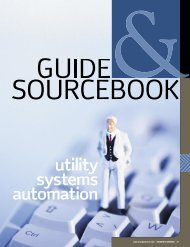Intelligent Utility Jan-Feb 2013
Intelligent Utility Jan-Feb 2013
Intelligent Utility Jan-Feb 2013
Create successful ePaper yourself
Turn your PDF publications into a flip-book with our unique Google optimized e-Paper software.
Con Edison crews at work in lower Manhattan the day after Hurricane<br />
Sandy hit New York City. They worked through the night pumping water<br />
from basements and substations. Courtesy of Con Edison.<br />
benefits. A smarter grid would also reduce CO2 emissions by<br />
12 to 18 percent.<br />
Amin’s cost estimates range somewhere between $338 billion<br />
and $476 billion for a smarter grid, and about $82 billion for<br />
a stronger grid. When those dizzying numbers are recast as<br />
a 20-year project, that’s a cost of $25 billion to $30 billion a<br />
year for 20 years. (Hurricane Sandy’s<br />
impact led New York alone to request<br />
$42 billion in federal aid, and<br />
in December 2012, economists were<br />
crediting the storm with significantly<br />
slowing the national economy.)<br />
“Don’t forget, this investment<br />
means job creation,” Amin added.<br />
“And it’s cheaper to pay for now than<br />
down the road. Interest rates are<br />
at an all-time low. Investment in a<br />
stronger, smarter grid means that for<br />
every dollar we spend, it’s going to have an economic return<br />
of $2.80 to $6 per dollar that goes into smart grid. To reach<br />
these numbers we used a very narrow definition of ‘smart<br />
grid.’ If you widen that definition, the benefits would increase.<br />
Conservatively, for every dollar spent on smart grid, including<br />
localized upgrades, the benefit would be about 3 to 6 times<br />
return on investment in terms of jobs and economic output.”<br />
“A lot more needs to be done for the benefit of smart grids<br />
to kick in,” Amin concluded.<br />
Sandy exposed the<br />
Smarter practices, including customers<br />
Smart grids are only a piece of the puzzle to greater resiliency<br />
Amin and Mansoor both suggested. Other utility practices,<br />
such as using small, camera-equipped drones and mobile<br />
imaging technology to assess and pinpoint damage should<br />
be added to the tool kit, they suggested.<br />
Better-prepared, more self-sufficient homes, businesses<br />
and communities should take steps to weather events.<br />
“<br />
tremendous opportunity<br />
we have to partner with<br />
consumers to speed up<br />
the restoration process. ”<br />
Microgrids, solar arrays that can island when the grid is<br />
down, hand-cranked radios and cell phones can provide<br />
emergency communications.<br />
“Sandy heightens the opportunity for innovation,”<br />
Mansoor said. “The changes on the customer side? How<br />
many of us had iPhones and tablets five years ago? Today, 30<br />
percent of utility customers don’t have landlines. Sandy exposed<br />
the tremendous opportunity we have to partner with<br />
consumers to speed up the restoration process. We’ll have to<br />
educate our customers.”<br />
Hurdles to forward progress<br />
Lewis, whose clients include utilities, is concerned that faultfinding<br />
may trump progress.<br />
“I think there’s merit in looking at [utility responses],”<br />
Lewis said. “The utilities didn’t do everything right, by any<br />
means. I just fear that with the number of investigative agencies<br />
and lawsuits involved, it’s really going to distract utility<br />
managers from their day job.”<br />
Amin called attention to the process<br />
under which change must occur.<br />
“One important constraint is the<br />
regulatory oversight of grid modernization,”<br />
Amin said. “Jurisdiction over<br />
the grid is split: the bulk electric system<br />
is under federal regulation, but<br />
the distribution grid is under statelevel<br />
public utility commissions. And<br />
those local regulations essentially kill<br />
the motivation for any utility or utility<br />
group to lead a regional or nationwide effort. So we need a<br />
policy framework to provide incentives for a collaboration in<br />
grid modernization and for research and development.”<br />
The bigger picture<br />
The 20th-century grid exceeded our expectations for basic<br />
services, rural electrification and economic development,<br />
Amin said. But the power grid, like water, transportation<br />
and communication, are in need of serious investment to<br />
maintain national competitiveness, let alone resiliency in a<br />
major storm.<br />
“We have not advanced our infrastructure sufficiently,”<br />
Amin said. “The World Economic Forum’s recent competitiveness<br />
report ranked our U.S. infrastructure below 20th in<br />
most of the nine categories of infrastructure, and below 30<br />
for quality of air transport and electricity. We wouldn’t have<br />
settled for something like that in the 1950s or 1960s.”<br />
Phil Carson is editor-in-chief of <strong>Intelligent</strong> <strong>Utility</strong> Daily.<br />
WWW.INTELLIGENTUTILITY.COM 19


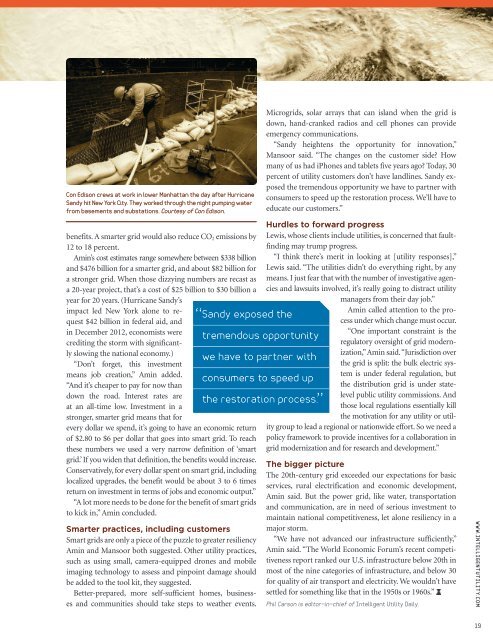
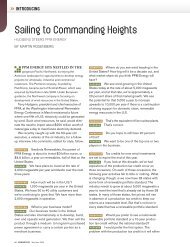
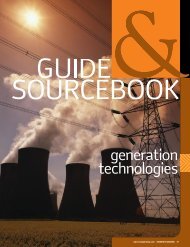
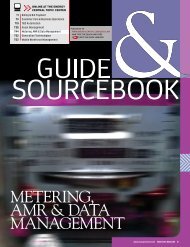





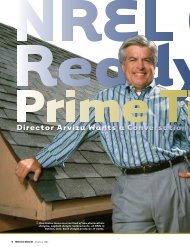



![View From the Trenches [PDF]](https://img.yumpu.com/18854438/1/190x252/view-from-the-trenches-pdf.jpg?quality=85)
